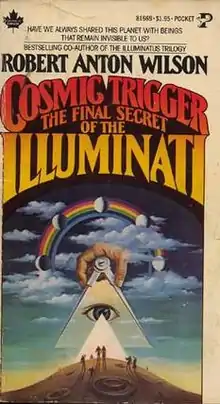Cosmic Trigger I: The Final Secret of the Illuminati
Cosmic Trigger I: The Final Secret of The Illuminati is the first book in the Cosmic Trigger series, first published in 1977 and the first of a three-volume autobiographical and philosophical work by Robert Anton Wilson.[1] It has a foreword by Timothy Leary, which he wrote in the summer of 1977. The first volume was published without numbering, as the second volume did not appear for nearly 15 years.
 First edition | |
| Author | Robert Anton Wilson |
|---|---|
| Country | United States |
| Language | English |
| Subject | Philosophy of language, consciousness |
| Publisher | Hilaritas Press |
Publication date | 1977 |
| Pages | 324 |
| ISBN | 0692513973 |
Wilson is perhaps best known as the co-author of the award-winning science fiction work The Illuminatus! Trilogy. Cosmic Trigger revisits many of the themes from that earlier work in a more autobiographical fashion. After publishing the first volume of Cosmic Trigger, Wilson wrote two sequels, Cosmic Trigger II: Down to Earth (1991) and Cosmic Trigger III: My Life After Death (1995), the title of the first book retroactively changing to reflect the series.
Cosmic Trigger I deals with Wilson's experiences during a time in which he put himself through a process of "self-induced brain change" as well as vignettes of his earlier life. The main discovery of this process—which, he tells us, is known in certain traditions as Chapel perilous—is that "reality" (although a noun in most Indo-European language systems, and therefore commonly conceptualized as being a definite, unchanging "'thing") is mutable and subjective to the observer.
Wilson employs several models for his experiences, such as the interstellar ESP connection, during which time Wilson enters what he refers to as a 'reality tunnel', in which he claims to communicate telepathically with extraterrestrials residing in the Sirius star system. Wilson states however, that this belief system does not necessarily have any objective truth, which highlights his main point: that all such models—whether spiritual or scientific—are just that: models, or maps, of the world, and they should not be confused with an objective, permanent reality. Throughout the book, he makes references to specific paranormal personal and group experiences, yet he does not allow himself to become convinced of their reality apart from his perception of them. He calls this approach "model agnosticism".
The book also deals with the Bavarian Illuminati conspiracy (which Wilson neither rejects as utterly false nor embraces as true, in keeping with his theme) and other related intrigues. The work also touches on a wide range of other subjects, from Timothy Leary's thoughts on brain circuits and JFK's assassination, through to Sufism and numerous occult practises.
Cosmic Trigger has been adapted as a theatrical stage play by Daisy Eris Campbell,[2] daughter of Ken Campbell the British theatre maverick who staged Illuminatus! at the Royal National Theatre in 1977. The new play opened on 23 November 2014 in Liverpool before transferring to London and Brighton.[3] Some of the costs were met through crowdfunding.[4] Wilson's book is itself dedicated to "Ken Campbell and the Science-Fiction Theatre of Liverpool, England."[5]
A new edition of Cosmic Trigger I, edited and with a new introduction by John Higgs, was published by Hilaritas Press on February 23, 2016. Hilaritas Press is the new publishing house created by the Robert Anton Wilson Trust.
The trilogy
- Cosmic Trigger I: The Final Secret of the Illuminati
- Cosmic Trigger II: Down to Earth
- Cosmic Trigger III: My Life After Death
References
- New York Times obituary, January 13, 2007
- "The Cosmic Trigger driving Miss Daisy". Liverpool Confidential. 23 January 2014. Archived from the original on 14 July 2014. Retrieved 12 June 2014.
- "The Play - What is it About?". Cosmic Trigger Play website. Retrieved 12 June 2014.
- "Cosmic Trigger Play crowdfunding campaign". Indiegogo. 23 May 2014. Retrieved 12 June 2014.
- Cosmic Trigger I: The Final Secret of the Illuminati (First Edition, Twenty-fourth Printing ed.). New Falcon Publications. 2013. p. dedication. ISBN 1-56184-003-3.
